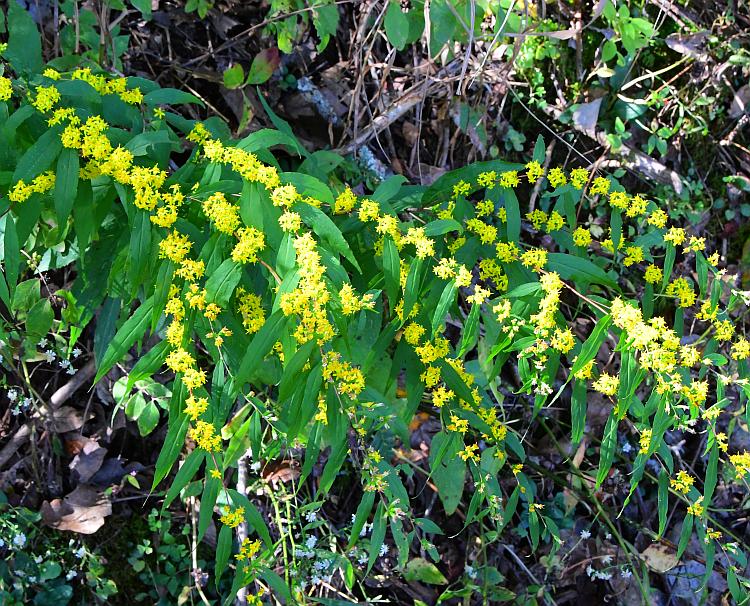Solidago caesia L.
Wreath Goldenrod

Native
CC = 7
CW = 3
MOC = 18
© SRTurner
Solidago caesia L.Wreath Goldenrod | |
 |
Native CC = 7 CW = 3 MOC = 18 |
© SRTurner |
|
Family - Asteraceae/Astereae Habit - Perennial forb with the rootstock short, stout, and sometimes branched, sometimes also producing long, slender rhizomes. Stem - Arched, 1 to several, to 1 m, sometimes with fine, inconspicuous, longitudinal lines but not noticeably ridged or grooved, glabrous, not shiny, often glaucous.
Leaves - Alternate, simple, sessile, chiefly cauline, the largest leaves in the lower 1/3 of the stem, the basal and lowest stem leaves absent at flowering. Basal and lowermost stem leaves with the blade 6-10 cm long, 1-3 cm wide, mostly 3-8 times as long as wide, narrowly elliptic-oblanceolate to elliptic or elliptic-obovate, relatively thin, tapered to a sessile base, tapered to a sharply pointed tip, the margins sharply toothed and usually inconspicuously hairy, the surfaces glabrous, the undersurface with 1 main vein, the fine, pinnate secondary veins usually relatively easily observed (these usually forming an irregular network). Median and upper stem leaves 2-8 cm long, elliptic-oblanceolate to narrowly elliptic, the margins of the uppermost leaves sometimes entire, otherwise similar to the lower stem leaves.
Inflorescences - Axillary clusters of heads, these oriented in several directions.
Heads - Involucre 2.5-4.5 mm long, the bracts in 3-5 unequal series. Involucral bracts mostly oblong and rounded to bluntly pointed (those of the outer series often oblong-lanceolate and sharply pointed) at the appressed-ascending tip, the thin, white to yellowish white margins hairy toward the tip, the outer surface glabrous, with a poorly defined, green central region toward the tip, this tapered abruptly to the midvein above or below the bract midpoint, the midvein often slightly thickened and sometimes with a faint, additional pair of veins present. Receptacle naked.
Flowers - Ray florets (1-)2-5, the corollas 3.0-3.5 mm long, yellow. Disc florets 5-9, the corollas 3.0-3.5 mm long, the lobes 0.9-1.5 mm long, yellow. Pappus 2.5-3.0 mm long, a few of the bristles often slightly thickened toward the tip. Fruits - Achenes 1.0-1.8 mm long, narrowly ellipsoid-obovoid, finely hairy.
Flowering - August - October. Habitat - Bases and ledges of shaded bluffs, streambanks, bottomland and mesic forests, roadsides. Origin - Native to the U.S. Lookalikes - None. Other info. - This is perhaps the most easily recognized species of goldenrod, and also one of the most attractive. Its arching stems with clusters of bright yellow flowers are a beautiful sight along shaded roadsides. Its range in Missouri is restricted to the southern quarter of the state, which is somewhat unusual because beyond Missouri it is found from the Gulf of Mexico all the way into Maine and parts of Canada. The plant is easily recognized when in flower by its arching stems with yellow inflorescence clusters. The stems are often, but not always, glaucous. Photographs taken at Caney Mountain Conservation Area, Ozark County, MO, 9-24-2017, Holly Ridge Conservation Area, Stoddard County, MO, 10-17-2017, and east of Zalma, Bollinger County, MO, 10-5-2021 (SRTurner). |